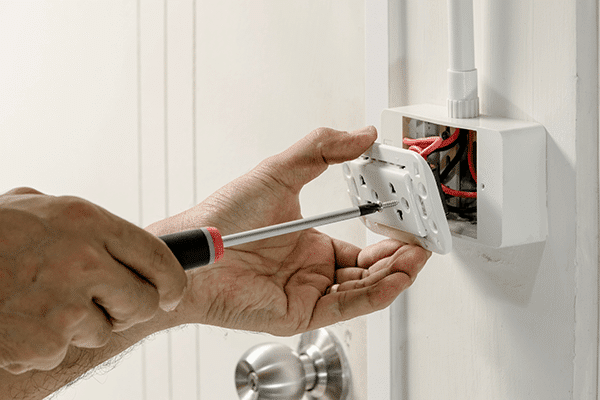Where To Place Electrical Outlets in New Home

Some aspects of building a new home are undoubtedly more exciting than others, but even the seemingly smallest considerations can have drastic impacts (positive or negative). One of those little details that you will be happy you took the time to plan in advance is the placement of electrical outlets in your new home. To help you decide, here is some information about where electricians commonly place electrical outlets in new homes.
Residential Electrical Codes
First and foremost, you need everything to fall in line with your local regulations. Every municipality puts specific requirements in place to keep homes safe and within compliance. Many places model their regulations from the NEC (National Electric Code), which is a reliable source of information. Still, it’s important to talk to a professional to learn about the regulations in your area because they can vary.
Main topics covered by electrical codes include:
- Installation procedures
- Outlet spacing
- Quality products
Outlet Spacing
Spacing requirements primarily prevent hazards from occurring while also ensuring that people have reasonable access to outlets in any room. Different rooms in the house have different requirements.
Living Areas

Bathrooms
In bathrooms, you need to install an outlet within 3 feet of the edge of the sink with the outlet above the counter if possible. This provides convenience and promotes safety.
Kitchens
In kitchens, the idea is to have an outlet every 2 feet. Outlets can’t be more than 4 feet apart along the walls and no more than 20 inches above the countertop.
Exceptions
There may be exceptions for people who require special accommodations or homes that don’t physically allow someone to safely adhere to the recommended spacing. A professional electrician can guide you through your local regulations.
Creative Outlet Placement
You probably think that your only option is to place electrical outlets in the wall, but you are wrong. You can place outlets in some sneaky locations that provide additional electrical coverage.
Here are some creative locations you may want to consider placing outlets:
- Floors
- Cabinets
- Islands
These options can improve the appearance of your walls by keeping the outlets out of sight, but they can be quite convenient, too!
Safety and Electrical Outlets
More important than convenience and appearance is safety. Professional electrical contractors can provide the following safety features to your outlets. In many cases, these safety items are required by the local building codes, but you can talk to your electrical contractor to clarify additional safety precautions that you want to put in place.
Amperage
Generally speaking, the circuit that each outlet in your home will service provide 15 or 20 amps. It is acceptable for 15-amp outlets to be installed on 20-amp circuits, but the power cannot go the opposite way. Placing a 20-amp outlet on a 15-amp circuit can lead to an over-surge of power and may result in shorting the circuit.
Tamper-Resistant Outlets
Tamper-resistant outlets are designed for child safety. A spring mechanism eliminates the worry of children or pets placing items into the outlet. These outlets are easily identified with a “TR” on the faceplate. Outlets behind large, stationary appliances (such as fridges or washing machines) and outlets higher than 5 feet 6 inches tall do not require tamper resistance.
GFCI Protection

Common areas with moisture include:
- Bathrooms
- Kitchens
- Laundry rooms
- Basements
- Garages
- Outdoors
- Pool/hot tub area
AFCI Protection
AFCI (arc-fault interrupter) protection on outlets eliminates danger from any arc faults. An arc fault refers to two wires sparking when they connect, and it generally occurs as a result of poor wiring or damage to the electrical system. The AFCI protection can be applied to individual outlets but is usually applied to the entire circuit. Similar to GFCI protection, when activated, AFCI protection will shut down the circuit. To regain normal power, you will need to flip the appropriate switch in the circuit breaker.
Technologically Advanced Options
We live in a world powered by technology, and this applies to your electrical outlets, too. Look into the following updated outlet options to truly bring your house into the new age. You’ll appreciate the convenience, and the outlets will also attract future homebuyers looking for a modern option.
USB Outlets
Many manufacturers provide an easy option for people to charge their devices with a USB cord. This is great if someone has their computer or an adapter handy. You can now eliminate the need for a computer or an adapter by installing outlets that have USB slots right there on the faceplate alongside the traditional three-prong outlet.
Bluetooth Outlets
Turn your home into a smart home by installing outlets with Bluetooth capability. These outlets will allow you to control the power of any device through your smartphone. Not sure if you turned your light off when you left for work? Just check your smartphone! You can turn the light off from wherever you are. This technology is also convenient when you are comfy in bed but need to turn the television off.
Wi-Fi Outlets
Technology keeps us more aware of personal utility usage than ever before. Wi-Fi outlets keep track of what items in your home use the most electricity so you can make conscious efforts to stay efficient. Many Wi-Fi outlets also give you the opportunity to automatically cut off certain devices when they have used a certain amount of energy.
Contact Brennan Electric for All Your Electrical Needs
Brennan Electric provides full electrical services in the Seattle, WA, area. Whether you need new electrical installation for your new construction or renovation, electrical repairs, or rewiring, our professional technicians can keep you connected with fast, professional, and friendly service. We also install smoke and carbon monoxide detectors and are well-known throughout the Seattle area for our whole-house generators.
Call today to learn more about our services and to schedule an appointment with one of our electricians!
Contact Brennan Electric today

